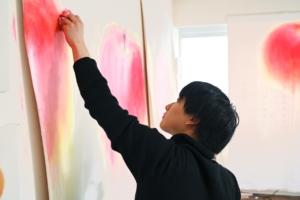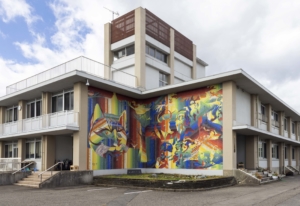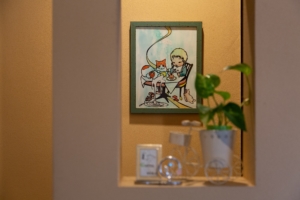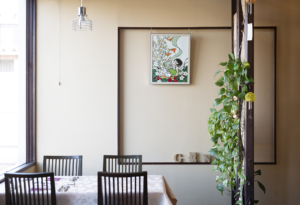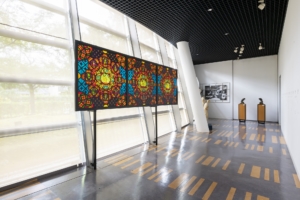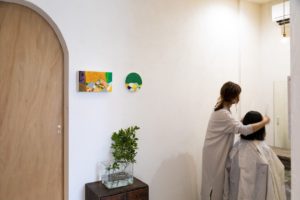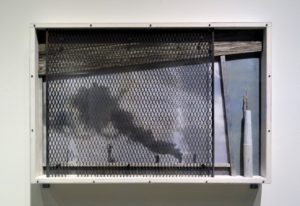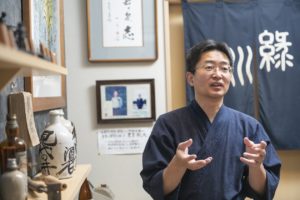ーYou have been in Ono City since 2003. Can you tell us about your work as an artist-in-residence?
At the time, I was working as an artist in Nagoya. I was invited by Kazumi Tsuji, a glass artist. It was a project where I rented a house and stayed there while creating. I love nature, and Ono City is a great place for me. It is a place that I still visit to chase fireflies and butterflies, and I can say that it is my second home.
ーTo arrive at the “baby” motif, I would like to know what you have been up to, Mr. Matsufuji. Please tell us the background of your work.
It is in my environment where I was born and raised. I was born in Nagasaki and grew up in Saga. When I was born, the remnants of the atomic bombing were still strong. In Nagasaki, there were graves scattered throughout the city. I often heard stories about the atomic bombing. I have acquaintances who lost family members in the atomic bombing and were taken in by other families. “The connection between family and the atomic bombing remained with me.
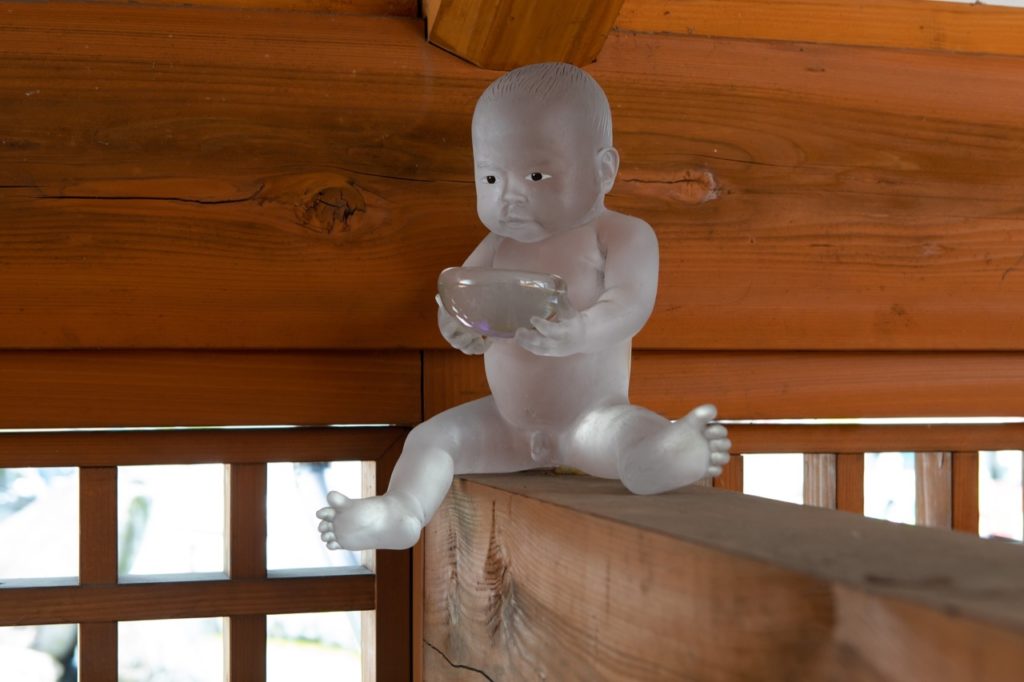
ーYou grew up in a place where you had to be aware of life and death from an early age. Why did you choose glass as your material?
I went to Aichi University of Education to become a painter. It wasn’t until I entered university that I encountered glass. Until then, I didn’t know how to use glass as a material for making art. For me, it was surprising and fresh, different from using a paintbrush.
Glass is reddish in the furnace, but becomes transparent when it cools down. The artificial material takes in light and releases its life force. It was quite fascinating. Glass babies are symbolic, imbued with life.
ーArtist-in-Residence How did you feel when you gave birth to your baby?
My baby works are like babies for prayer, babies to be prayed for, or Buddhas for people to pray to. In fact, I have received requests from individuals who felt this way. I have strong feelings about death, and I used to create works that reminded me of it. However, after the sudden death of my father, I decided to use the image of birth, a baby, as a motif.
ーWhy did the sudden death of your father make you so conscious of life as a counterpoint?
I wanted to live my life in a positive and forward-looking way. In my work, I decided to focus on life rather than death.
I had been making works with babies as motifs before I came to Ono, but my current baby statues were born in Ono. Before that, I used medical babies as motifs in general.

ーWhy did you choose that installation location?
The place where the baby sits in the station is not well lit. Perhaps it could be seen by ghosts. I chose the top of the beam because it is a place where you notice it when you suddenly look at it and its presence seems nice.
ーThe baby’s expression is not really that of a baby…
The face is very mature, isn’t it ?
-He’s holding something that looks like a drinking cup.
What he’s holding is a water cup. It is a ball of water. What I felt during my stay in Ono was the abundance of water and the people who live there. Ono City has an image of a puddle of water surrounded by mountains.
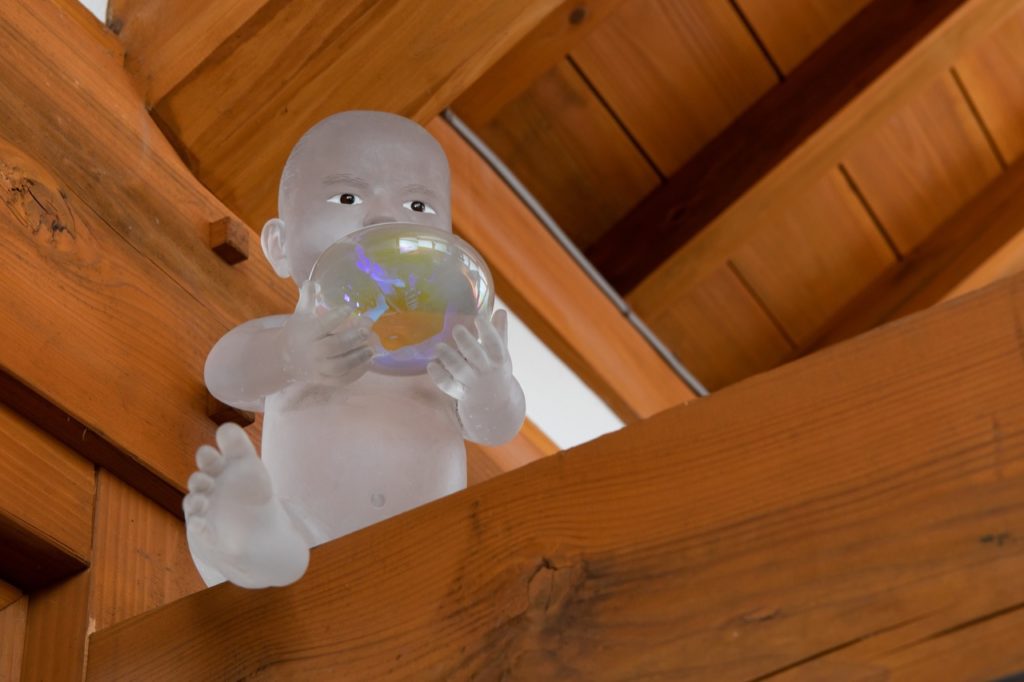
-I heard that you sometimes avoided dealing with the theme of life and death?
In the beginning, I was making works with images of dead bodies. Conscious of the social issues of the time, I started using babies as my motif. Later, it became the original baby statue.
What do you mean by “I avoided dealing with life and death”? For me, my family and relatives were so close to me that I avoided dealing with life and death in my works that were conscious of the atomic bombing.
-Your uranium glass works have a strong sense of life and death.
After experiencing the Great East Japan Earthquake in 2011, I lost my resistance to using death as a motif. After the nuclear accident in Fukushima in 2011, I started to make uranium glass works, thinking that I should not avoid it, but face it as well.
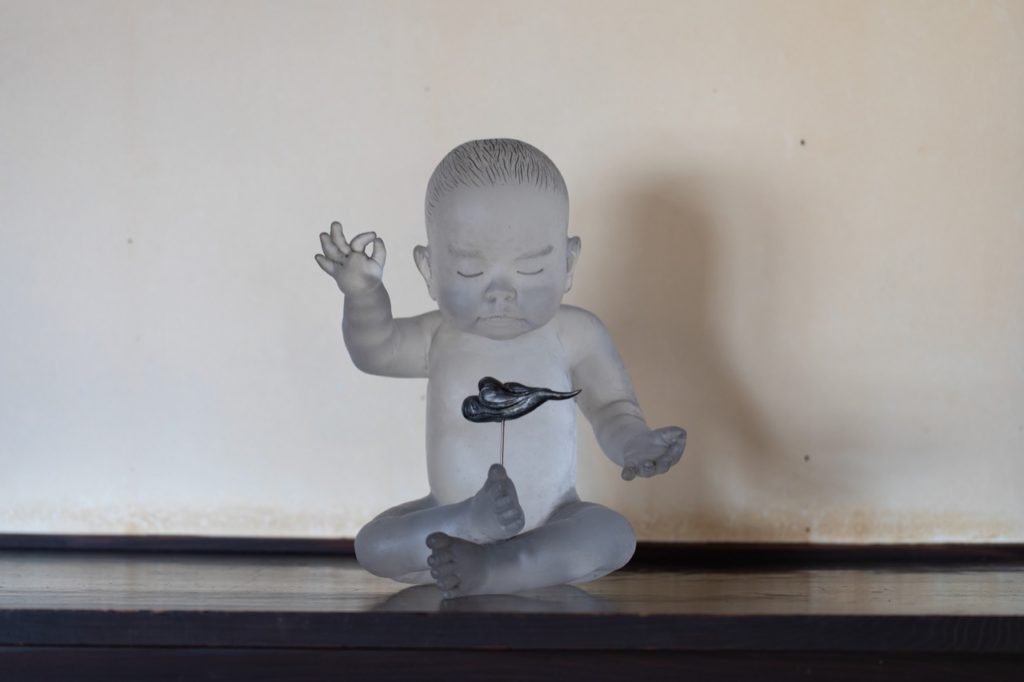
-The uranium glass piece was a glowing installation in the storehouse. Unlike the baby piece, I found it fantastic and beautiful, but also disturbing.
We are living in a civilized world. Civilization is bright, and there is a sense of pleasure in being absorbed in it without even knowing it. However, if we stay in a clean place too long, we become comfortable and cannot escape.
Uranium glass emits a beautiful fluorescence when exposed to ultraviolet light. Less than one percent of uranium is responsible for this beauty. On the other hand, the energy of uranium is used for military purposes, and it is also used for principle power generation. I want to express what danger is, what beauty is, and what harmony of light is.
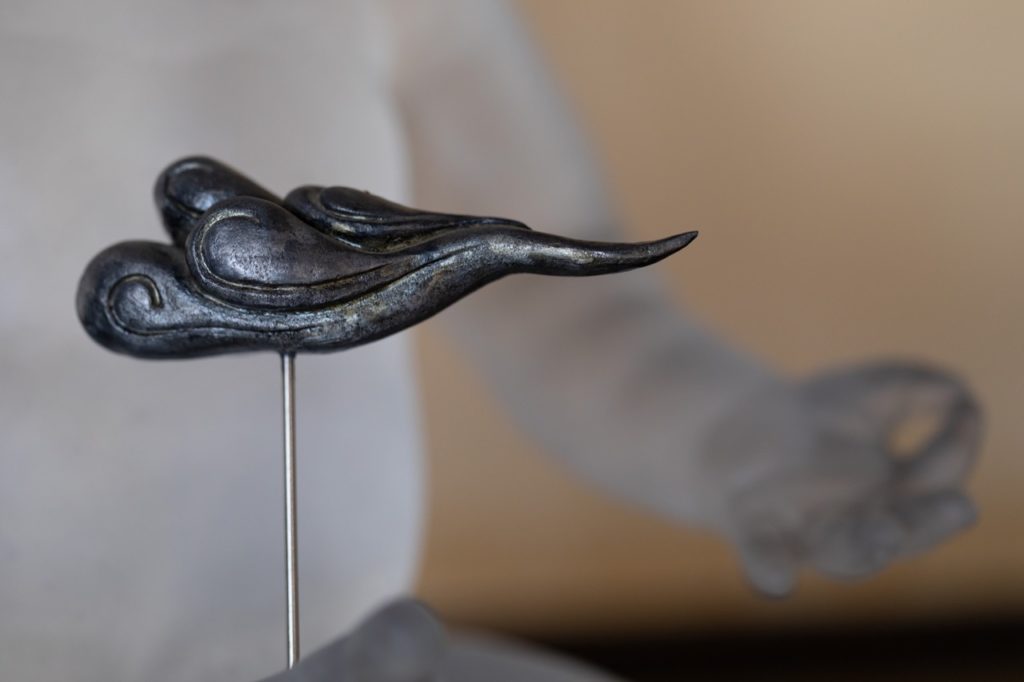
-I would like to hear more about your work with uranium glass and your intentions. I would like to hear more about your work with uranium glass and your intentions. Thank you very much for your time.
松藤孝一 Matsufuji Kouichi
Career
Born in Nagasaki, Japan in 1973, and grew up in Saga. After graduating from Aichi University of Education in 1995, he studied in the United States on a Researcher Overseas Grant from the Pola Art Foundation. He received his Masters of Fine Arts degree from Illinois State University School of Art in 2001. At present he resides in Toyama, Japan.
http://www.koichimatsufuji.com/
Solo Exhibitions
2013 Gallery Cellar, Tokyo, Japan.
2010 Gallery Cellar, Tokyo, Japan.
2009 Gallery Cellar, Tokyo, Japan.
2008 Aichi Prefectural Museum of Art space 6, Nagoya, Japan.
2006 Gallery Plannet, Nagoya, Japan.
2004 Gallery Q, Tokyo, Japan.
2002 Gallery Ten, Kanazawa, Japan.
2001 Gallery Q, Tokyo, Japan.
Selected Group Exhibitions
2016 “ TOYAMA GLASS -No limit No border- ” Toyama Glass Art Museum, Toyama, Japan.
2016 “ Kohei Kishimoto and Koichi Matsufuji Exhibition ” Seto Ceramics and Glass Art Center, Aichi, Japan.
2013 “ Aichi Triennale 2013 ” Curatorial Competition in Choja-machi District, Nagoya, Japan.
2007 “ Young Glass 2007 ” Glasmuseet Ebeltoft, Denmark.
2007 “ The Fires Burn On ” American Glass Museum, NJ, United States.
2006 “ For Rent! For Talent! 2 ” Mitsubishijisho Artium, Fukuoka, Japan.
2004 “ The Another Situation of Image XIV ” Gallery Suzuki, Kyoto, Japan.
2003 “ 20/20 Vision ” American Glass Museum, NJ, United States.
2003 “ THE 90’s ” Glasmuseet Ebeltoft, Denmark.
2003 “ Cutting Edge: Contemporary Art in the Permanent Collection ” Rockford Art Museum, IL, United States.
Awards
2007 The Holmegaard Prize, Glasmuseet Ebeltoft, Denmark.
2006 Art Cultural Grant, The Nomura Cultural Foundation, Tokyo, Japan.
2000 The Dean Alan Olson Purchase Award, Rockford Art Museum, IL, United States.
1998 The Researcher Overseas Grant, Pola Art Foundation, Tokyo, Japan.
Selected Residences & Workshops
2005 UrbanGlass, Spring workshop, NY, United States.
2004 Ichinomiya City Memorial Art Museum of Setsuko Migishi, workshop, Aichi, Japan.
2004 The Glass Furnace, workshop, Istanbul, Turkey.
2003 Ono Art Wave, Artist in Residence, Fukui, Japan.
2002 Edward F. Albee Foundation, Artist in Residence, N, United States.
1997 Creative Glass Center of America, Artist in Residence, NJ, United States.
Public Collections
2014 The Bergstrom-Mahler Museum of Glass, Wisconsin, United States.
2007 Glasmuseet Ebeltoft, Denmark.
2004 The Glass Furnace, Istanbul, Turkey.
2003 JR Echizen Ono Station and Samurai Residence of the Old Uchiyama Family, Fukui, Japan.
2000 Rockford Art Museum, Illinois, United States.
1997 American Glass Museum, New Jersey, United States.
Commission Works
2008 Brother Communication Space, Nagoya, Japan.
2007 Mino Kagayaki no mori, Gifu, Japan.
Bibliography
2013 “ Aichi Triennale 2013 Official Catalogue” Aichi Triennale Organizing Committee.
2010 “ 100 people of the new sculpure artists” Artcollector Magazine August 2010 No21.
2009 “ A Special Issue Sculptor 20’09 ” Gallery Magazine, August 2009.
2008 “ -The Brimming Universe – / NAKAMURA, Hideki The Nikkei ” Newspaper, November 27, 2008.
2006 “ Gallery Review / MORI, Miki ” BT Magazine, January 2007.
2004 “ -Bird- / YASUDA, Emi ” Art Review Magazine REAR no.7.
2003 “ International Glass Art / Richard Wilfred Yelle” Schiffer publication
